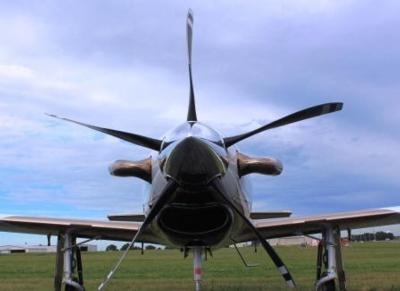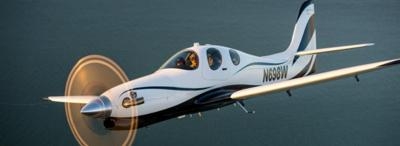Tue, Jul 19, 2016
Company Projects Boosts In Aircraft Speed, Climb Rates
Evolution Aircraft has completed extensive performance and noise testing confirming the performance improvements of the new Hartzell five-blade composite swept tip constant speed prop for the Turbine Evolution.

The new technology 82.5-inch diameter five-blade propeller is available as an optional performance upgrade in place of the four-blade Hartzell aluminum propeller that is standard equipment on the Turbine Evolution. In addition to new aircraft kits, the new carbon fiber propeller is available as an upgrade for the 65 Turbine Evolutions flying today. Even though the new propeller has one more blade, it is 3.5 pounds lighter than the standard propeller including spinner and de-ice.
In flight tests comparing the four-blade aluminum prop with Hartzell's new five-blade structural composite propeller, Elite Pilot Services documented a three knot increase in cruise speed and a 144 feet per minute increase in climb rate in the Turbine Evolution. "This gives pilots and owners of the Turbine Evolution a new propeller option to get higher faster and fly faster at altitude," said Evolution Aircraft CEO Bob Wolstenholme.
"Much like the Turbine Evolution itself, modern propeller technology, advanced manufacturing methods and advanced aerodynamics combine to bump the airplane's speedy performance to the next level," said Hartzell Propeller President Joe Brown. "With Hartzell's true carbon fiber propeller blades and the Turbine Evolution's all carbon fiber airframe, this legendary high performance aircraft goes even faster and has an even better climb rate."

The new five-blade Hartzell carbon fiber prop will be displayed on a Turbine Evolution aircraft during EAA AirVenture. Hartzell Propeller will also exhibit its other composite technology props, including a swept-tip Trailblazer prop at its Exhibit Booth.
Pilot and CFI Sean E. VanHatten with Elite Air Services conducted the flight performance comparisons. "Time to climb, true airspeed at various altitudes, and propeller braking were all quantified. General handling characteristics and subjective pilot observations were also noted," he wrote in his report. "On average, the five blade propeller results in three knots faster true airspeed, 144 feet per minute faster rate of climb, and a 13 percent increase in deceleration
(Images provided with Hartzell news release)
More News
He Attempted To Restart The Engine Three Times. On The Third Restart Attempt, He Noticed That Flames Were Coming Out From The Right Wing Near The Fuel Cap Analysis: The pilot repor>[...]
Make Sure You NEVER Miss A New Story From Aero-News Network Do you ever feel like you never see posts from a certain person or page on Facebook or Instagram? Here’s how you c>[...]
From 2009 (YouTube Edition): Leading Air Show Performers Give Their Best Advice for Newcomers On December 6th through December 9th, the Paris Las Vegas Hotel hosted over 1,500 air >[...]
Aero Linx: NASA ASRS ASRS captures confidential reports, analyzes the resulting aviation safety data, and disseminates vital information to the aviation community. The ASRS is an i>[...]
“For our inaugural Pylon Racing Seminar in Roswell, we were thrilled to certify 60 pilots across our six closed-course pylon race classes. Not only did this year’s PRS >[...]
 NTSB Final Report: Rutan Long-EZ
NTSB Final Report: Rutan Long-EZ ANN FAQ: Turn On Post Notifications
ANN FAQ: Turn On Post Notifications Classic Aero-TV: ICAS Perspectives - Advice for New Air Show Performers
Classic Aero-TV: ICAS Perspectives - Advice for New Air Show Performers ANN's Daily Aero-Linx (06.28.25)
ANN's Daily Aero-Linx (06.28.25) Aero-News: Quote of the Day (06.28.25)
Aero-News: Quote of the Day (06.28.25)




